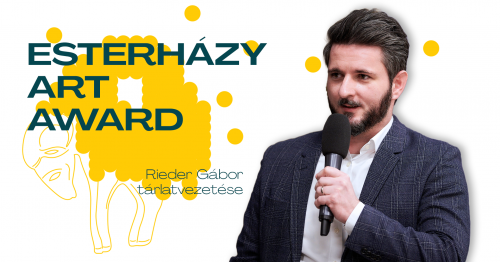Luca Sára Rózsa, Kata Tranker and Ádám Ulbert are the winners of the Esterházy Art Award 2021. The prize is awarded every two years and the exhibition accompanying the award is considered the most valuable survey of the young Hungarian art scene.
The 26 nominees were selected by a jury of experts from a pool of 282 applicants. The exhibition entitled Esterházy Art Award – Young Scene Hungary – Short List 2021 will be on view from the 1st December 2021 to the 13rd February 2022 at the Ludwig Museum – Museum of Contemporary Art, Budapest.
This year’s exhibition is dedicated by the Esterházy Privatstiftung to Pál V, Prince Esterházy (1901–1989), a great patron of Hungarian science and culture. Recent research has revealed that Pál Esterházy founded the Esterházy Prize as early as 1937. His activities as a patron, which had a great impact on Hungarian cultural life, have been reflected on by Marcell Esterházy in a video collage displayed in the first room of the exhibition.
Young Scene Hungary – Short List 2021
As a continuation of the Esterházy family’s history in Central Europe and long tradition of patronage, the Esterházy Privatstiftung has been supporting contemporary art in Hungary since 2009 with a biennial award and the related exhibition. The shortlisted artists and the three winners, who each receive €5,000, are selected by an independent international jury.
The number of entries submitted to Esterházy Art Award was 282. The expert jury nominated 26 artists for this year’s award from this impressive pool of applicants. Due to its size, central role and careful selection of nominated artists, the exhibition related to the award represents the most significant overview of the art scene of young Hungarian talents.
The cultural significance of the Esterházy Art Award lies not only in supporting contemporary art, but also in the opportunity to explore new tendencies and attitudes in society.
A surprising number of entries selected for the Short List 2021 deal with the role of materiality and corporeality. There are also many narrative approaches. However, abstract and self-reflexive artistic traditions that seemed important earlier have almost disappeared.
The exhibition intends to serve these tendencies: the entries which earlier appeared typically isolated in the exhibition space now engage in dialogue with one another. For example, one of the works displayed appears dispersed in all the spaces of the exhibition. This arrangement allows for observation
to decide whether the relationships established this way across the borders of different artistic worlds will foster inspiring friendships or create dangerous situations of rivalry.
The Esterházy Art Award 2021 Nominees and Exhibiting Artists:
BALÁZS Nikolett, BILAK Krystyna, CZENE Márta, DALLOS Ádám, DÓRA Ádám, EJTECH (KÁRPÁTI Judit Eszter és Esteban de la TORRE), FÁBRI Zachary, FRIDVALSZKI Márk, HORESNYI Bálint, KÁDÁR Emese, KISS Adrian, KISS Adrienn Mária, KOÓS Gábor, KÚTVÖLGYI-SZABÓ Áron, MELKOVICS Tamás, NEOGRÁDY-KISS Barnabás, PINTÉR Gábor, RÓZSA Luca Sára, RUDAS Klára, SCHWÉGER Zsófia, SÜVEGES Rita, SZABÓ Eszter, TOLLAS Erik, TRANKER Kata, TRAPP Dominika, ULBERT Ádám
This year’s three winners were chosen by an independent international jury of experts after a constructive debate.
The winners of the 2021 Esterházy Art Award are Sára Luca Rózsa, Kata Tranker and Ádám Ulbert.
The prize, worth €15,000 in total, will be divided equally between the three winners.
The jury’judgement:
Luca Sára Rózsa’s (✽1990 Budapest, lives and works in Budapest) intense works permeated with psychoanalytic connotations reveal an authentic and very contemporary painter. Her huge canvases are reminiscent of Renaissance portrait painting, depicting naked bodies in a specific natural setting. Yet for all her painterly skill, Rózsa is not interested in the mode of representation, but goes much deeper, exploring the psychological levels of subject and nature, revealing the tensions and even dualities within each individual personality. While searching for the utopian Arcadia, a way out of the present to another world, she finds herself in the future or in the past. Her works are much in tune with our complicated everyday lives.
Kata Tranker (✽1989 Székesfehérvár, lives and works in Budapest) This is the third time that Kata Tranker has been selected for the shortlist of the Esterházy Art Award. Members of the jury have seen her work evolve from the utilisation of a distinctly small scale and ephemeral materials in 2015 and 2019 to larger sculptures and installations that first appeared in the exhibition at the Collegium Hungaricum in Berlin in 2021.
Her anthropomorphic imaginary creatures address mythological and prehistoric narratives as well as the world of science fiction while at the same time bringing in subjective personal experiences of coexistence and motherhood.
Tranker’s curiosity in a wide range of scientific and scholarly fields is coupled with her interest in art seeping into daily life and transgressing realities.
Ádám Ulbert (✽1984 Budapest, lives and works in Budapest), who studied in Amsterdam, represents an individual, mature, international voice in every sense of the word on the Hungarian art scene. His expressive painting combines scientific theories and mythological topoi, creating personal narratives.
In his recent series, he explores the exotic language of Japanese culture in the context of family heritage, describing a never existent bizarre destination of longing. His figurative canvases and three-dimensional bronze sculptures reveal the metaphorical possibilities of imaginative freedom, particularly relevant today.
Jury Members:
Sandro DROSCHL, Director of Künstlerhaus, Halle für Kunst & Medien, Graz
FABÉNYI Julia, Director of the Ludwig Museum – Museum of Contemporary Art, Budapest
OTTRUBAY István, Founder of the Award, Director of the Esterházy Foundation, Eisenstadt
RIEDER Gábor, PhD, Art Historian, Curator, Art Writer, Chief Editor of ArtKartell, Budapest
SZEGEDY-MASZÁK Zsuzsanna, PhD, Art Historian, Curator, Chief Museologist of the Historical Photographic Collection of the Hungarian National Museum, Budapest
Vitus WEH, Contemporary Art Consultant of the Esterházy Foundation, Eisenstadt
Luisa ZIAJA, Curator of Contemporary Art of Belvedere 21, Vienna
Sustainable Support
This year’s winners will have an exhibition in the White Room of the Esterházy Castle in Kismarton in the spring of 2022 and a previously commissioned installation in the castle’s grand staircase will be created by Ádám Ulbert.
The Foundation will continue to follow the work of previous winners including BORSOS LŐRINC, HORVÁTH Dániel, SIEGMUND Ákos (2009), KIRÁLY András, KARÁCSONYI László Attila, SZABÓ Ábel (2011), CSATÓ József, KALICZKA Patrícia, KOVÁCS Olívia (2013), MAKAI Mira Dalma, KASZÁS Tamás, TIBOR Zsolt (2015), EZER Ákos, KERESZTES Zsófia, NAGY Imre (2017), GYŐRI Éva Andrea, NEMES Márton, PUKLUS Péter (2019).
The exhibition also pays artistic tribute to Pál V, Prince Esterházy (1901–1989), who founded the first Esterházy Art Award in 1937. His activities as a patron, which had a great impact on Hungarian cultural life and still serve as a model for the Esterházy Privatstiftung today, have been reflected on by Marcell Esterházy (1977) in a video collage entitled The Short Story of E. Pál.
This video, presented in the first room of the exhibition, is a subjective portrayal of Esterházy Pál’s life and patronage activities. It tells the story of the family through its ancestors, shows excerpts from newspaper articles about the Esterházy Award from the early 1940s and reveals interesting parallels between the photographs taken during the Mindszenty trial in 1949 and letters of thanks written by painters a few years earlier.
The Esterházy princes supported music and arts throughout the centuries. The last prince, Pál V Esterházy was one of the outstanding patrons. This fact has now come to the spotlight again as a result of the latest research of Noémi Viskolcz.
He awarded grants to talented law students and young research doctors, saved the Hungarian Academy of Sciences and the Hungarian Royal Opera House from going bankrupt and generously patronised several music events. He supported the fine arts of his era through purchases and commissions.
He founded the Esterházy Art Award in 1937. Until 1942, the awardees were selected by the National Art Society of Hungary in the categories of Hungarian historical painting, Hungarian genre painting and sculpture. Only World War II and the following change of regime, during which he was imprisoned, put a stop to his extensive activities as a patron.






Related contents

Virtual tour in the Esterházy Art Award 2021 exhibition
Due to its size, central role and careful selection of nominated artists, the exhibition related to the award represents the most significant overview of the art scene of young Hungarian talents.




